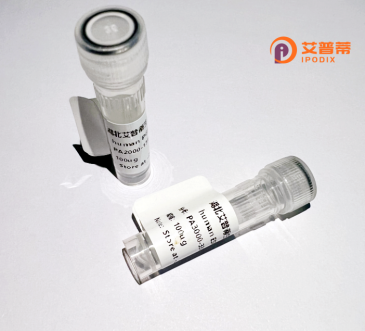
| 纯度 | >90%SDS-PAGE. |
| 种属 | Human |
| 靶点 | PCBP4 |
| Uniprot No | P57723 |
| 内毒素 | < 0.01EU/μg |
| 表达宿主 | E.coli |
| 表达区间 | 1-403 aa |
| 活性数据 | MSGSDGGLEE EPELSITLTL RMLMHGKEVG SIIGKKGETV KRIREQSSAR ITISEGSCPE RITTITGSTA AVFHAVSMIA FKLDEDLCAA PANGGNVSRP PVTLRLVIPA SQCGSLIGKA GTKIKEIRET TGAQVQVAGD LLPNSTERAV TVSGVPDAII LCVRQICAVI LESPPKGATI PYHPSLSLGT VLLSANQGFS VQGQYGAVTP AEVTKLQQLS SHAVPFATPS VVPGLDPGTQ TSSQEFLVPN DLIGCVIGRQ GSKISEIRQM SGAHIKIGNQ AEGAGERHVT ITGSPVSIAL AQYLITACLE TAKSTSGGTP SSAPADLPAP FSPPLTALPT APPGLLGTPY AISLSNFIGL KPMPFLALPP ASPGPPPGLA AYTAKMAAAN GSKKAERQKF SPY |
| 分子量 | 41.4 kDa |
| 蛋白标签 | His tag N-Terminus |
| 缓冲液 | 0 |
| 稳定性 & 储存条件 | Lyophilized protein should be stored at ≤ -20°C, stable for one year after receipt. Reconstituted protein solution can be stored at 2-8°C for 2-7 days. Aliquots of reconstituted samples are stable at ≤ -20°C for 3 months. |
| 复溶 | Always centrifuge tubes before opening.Do not mix by vortex or pipetting. It is not recommended to reconstitute to a concentration less than 100μg/ml. Dissolve the lyophilized protein in distilled water. Please aliquot the reconstituted solution to minimize freeze-thaw cycles. |
以下是关于重组人PCBP4蛋白的3-4篇参考文献的简要概述:
---
1. **文献名称**:*"PCBP4 inhibits the tumorigenesis by inducing apoptosis via Bax/Bcl-2 pathway"*
**作者**:Ji Y, et al. (2015)
**摘要**:该研究探讨了PCBP4作为RNA结合蛋白的肿瘤抑制功能,发现其通过上调促凋亡蛋白Bax并抑制Bcl-2表达,诱导癌细胞凋亡,提示其在癌症治疗中的潜在靶点作用。
---
2. **文献名称**:*"PCBP4 regulates the transcription and alternative splicing of apoptosis-related genes in colorectal cancer"*
**作者**:Wang H, et al. (2020)
**摘要**:研究发现重组PCBP4通过调控凋亡相关基因(如p53和Caspase家族)的转录及可变剪接,抑制结直肠癌细胞增殖,并揭示其与DNA损伤修复通路的关联。
---
3. **文献名称**:*"PCBP4 mediates the terminal oligopyrimidine (TOP) motif-dependent stability of mRNAs encoding ribosomal proteins"*
**作者**:Chen L, et al. (2018)
**摘要**:该文献揭示了PCBP4通过结合TOP-motif维持核糖体蛋白mRNA稳定性,其重组表达可调控细胞增殖和翻译效率,尤其在缺氧条件下影响肿瘤生长。
---
4. **文献名称**:*"Overexpression of PCBP4 suppresses tumor progression via inhibiting EMT in colorectal cancer"*
**作者**:Zhang R, et al. (2017)
**摘要**:研究证明重组PCBP4过表达通过抑制上皮-间充质转化(EMT)关键标志物(如E-cadherin和Snail),减少结直肠癌细胞侵袭转移,提示其作为转移抑制因子。
---
以上文献均从不同角度探讨了PCBP4在癌症调控中的分子机制及重组蛋白的应用潜力,涵盖凋亡、RNA稳定性、翻译调控及转移抑制等方向。
Poly(rC)-binding protein 4 (PCBP4), a member of the heterogeneous nuclear ribonucleoprotein family, is an RNA-binding protein implicated in post-transcriptional gene regulation. It contains three K-homologous (KH) domains critical for binding poly(C) motifs in RNA, enabling interactions with mRNAs or non-coding RNAs to modulate stability, splicing, or translation. PCBP4 is recognized as a tumor suppressor, with roles in apoptosis, cell proliferation, and differentiation. It regulates targets like p21 and p53 by stabilizing their mRNAs or enhancing translation through internal ribosome entry site (IRES)-dependent mechanisms. Dysregulation of PCBP4 is linked to cancer progression; reduced expression is observed in lung, liver, and glioblastoma tumors, correlating with poor prognosis. Its loss may promote tumorigenesis by disrupting cell cycle control and apoptotic signaling. Recombinant human PCBP4. produced via bacterial or mammalian expression systems, retains RNA-binding activity and is used to study its molecular functions. This engineered protein aids in exploring therapeutic strategies, such as restoring PCBP4 activity in cancers or leveraging its RNA-regulatory properties for targeted interventions. Current research focuses on clarifying its context-dependent roles and interactions within signaling networks to harness its potential in precision oncology.
×